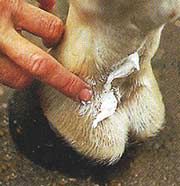Cracked
Heels in Horses - cause, treatment and prevention
 Apply antiseptic to cracked
Apply antiseptic to cracked
heels once they have been
washed and dried Cracked Heels , sometimes known as greasy heel,
are a common problem for horses and ponies.
Cracked heels usually occur in horses which are turned out in
a field for part of the day - but a few wet muddy rides out can
also trigger the problem.
Washing a horse's legs can also cause cracked heels if
the legs are not dried thoroughly .
Cracked heels are not actually cracks in the heel of the foot!
It is an equine skin condition which occurs
in the hollow of the pastern where the horse's skin is particularly
delicate.
Horses with white legs are more likely to suffer from cracked
heels.
The first signs of cracked heels are scurf and scabs in the hollow
of the pastern. Don't just look, but also feel for these every
time that you pick you horse's feet out.
If you spot these symptoms early you should
be able to treat the problem before it gets serious.
If cracked heels aren't spotted in time the scabs may increase
and can eventually cover a wide area.
When the scabs fall off, painful cracks will
show underneath and may cause the horse to go lame.
Because the cracks are so low down the leg they can easily become
infected.
It is quite tricky to apply dressings, and get
them to stay on, to this part of the horse's leg. So if you can
avoid letting the condition get to this stage so much the better.
Some horse owners refer to cracked heels as Mud
Fever which is a similar condition generally affecting the
horse higher up his legs
The first step in treating equine cracked heels
is to bring the horse or pony into a clean dry area.
The scurf and scabs should then be washed off with a warm antiseptic
solution. This may not be easy as the horse will be quite
sore in this area and may not like you touching his legs.
If your horse is fairly hairy with a lot of feathers it may be
best to to trim his heels. Although the thick
hair does give some protection to the legs in wet conditions it
will make washing and drying the legs more difficult and may slow
down the healing process.
When the heels are completely dry - use a hairdryer if necessary
- apply a thick layer of equine antiseptic healing cream
or ointment.
If possible keep the horse or pony stabled -
unless you have a dry paddock or area to turn him in.
As well as preventing infection the cream will
moisturise and soothe the heels in the same way that hand cream
helps chapped skin in humans.
If your horse isn't lame he can be exercised
but try not to ride across muddy fields
and tracks.
|